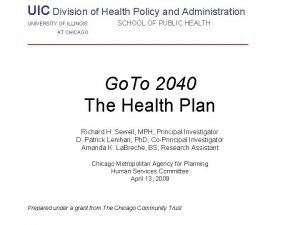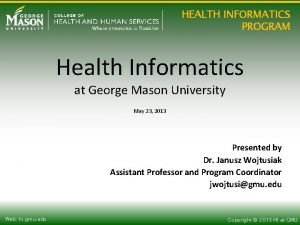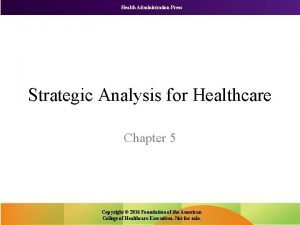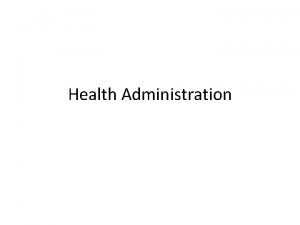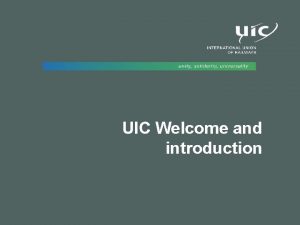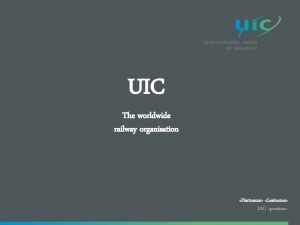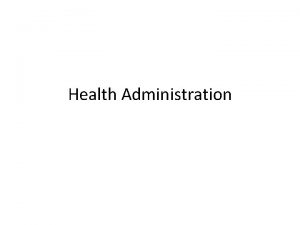UIC Division of Health Policy and Administration UNIVERSITY













- Slides: 13

UIC Division of Health Policy and Administration UNIVERSITY OF ILLINOIS SCHOOL OF PUBLIC HEALTH AT CHICAGO ___________________________ Go. To 2040 The Health Plan Richard H. Sewell, MPH, Principal Investigator D. Patrick Lenihan, Ph. D, Co-Principal Investigator Amanda K. La. Breche, BS, Research Assistant Chicago Metropolitan Agency for Planning Human Services Committee April 13, 2009 Prepared under a grant from The Chicago Community Trust

Health Advisory Committee • • • Trish Anen, Metropolitan Chicago Healthcare Council Cynthia Barnard, Ph. D, Northwestern Memorial Hospital Andrea Bempong, Alliance of Chicago Community Health Services Joan D. Boomsma, MD, MBA, Metro. South Medical Center Patricia Canessa, Salud Latina Patricia Johnson, USDHHS Mike Jones, Illinois Department of Healthcare and Family Services Candace M. King, Du. Page County Federation on Human Services Reform Hong Liu, Ph. D, Asian Health Coalition of Illinois • • Terry Mason, MD, FACS, Chicago Department of Public Health Patrick Mc. Nulty, Mc. Henry County Health Department Harold Pollack, Ph. D, The Center for Health Administration Studies, University of Chicago Sylvia Puente, Latino Policy Forum Margie Schaps, Health and Medicine Policy Research Group Laura Schneider, Lake County Health Department Steve Seweryn, Cook County Department of Public Health Robert Vanecko, MD, Institute of Medicine of Chicago

Planning Considerations • Since health disparities exist based upon income, race, ethnicity, and other factors, targeting disparities ensures that areas of greatest need receive the most attention, thereby offering the greatest potential for overall health improvement. • While policy changes at the state and national level are needed, the focus of this effort is on what can be accomplished in the CMAP region to improve health and not on those factors that are beyond regional control.

Planning Considerations • Reducing the burden of chronic disease offers the greatest impact for improving the heath of all population groups. • The most cost effective interventions involve prevention and health promotion. These interventions are best carried out through non-health sectors where people live, work, are educated, and go about their daily lives.

Health and Health Systems Issues in Northeastern Illinois • While the region compares favorably, on most measures cited in this plan, to Illinois and the United States, there are populations of racial, ethnic, and economic minorities with alarming health statistics. • There are signs of a deteriorating public health infrastructure. • The regional health system is not performing well enough when the burden of chronic disease and its attendant costs are considered.

A Vision of Health and the Health System in 2040 in the CMAP Region • The Health Plan ties its vision for 2040 to CMAP’s Regional Vision for Metropolitan Chicago. An example is the vision for Sustainability: – “The CMAP vision requires an ability to meet ‘the needs of the present without compromising the future. ’ This anticipates the presence of health planning and health policy formulation above the level of service provider governing boards, local boards of health, and local elected officials. The formulation of health policy should be a higher priority and the process should be integrated with other regional planning concerns. Leadership in assuring quality of life, given contemporary environmental, economic, and public health challenges must develop and be consciously nurtured so that, by 2040, an evidence-based system response is possible. The vision of a future function of weighing the impact of health system decisions will allow sustainability of necessary resources. ”

Indicators • • • Infant Mortality Rate Disparities by County Age-adjusted death rates for selected leading causes of death by county. Diabetes – – • • Prevalence of “obese” and “overweight” in Cook County and Collar Counties among third graders Smoking – – • Prevalence of diabetes among adults in the CMAP region Trend in ambulatory sensitive hospitalizations for type 1 and type 2 diabetes mellitus Prevalence of smoking among adults Percent of 8 th graders who used tobacco in the last month Percent of 8 th graders who used alcohol in the last month • • Percent of 8 th graders who used marijuana in the last month Asthma – Prevalence of asthma – Trends in ambulatory sensitive hospitalizations for primary and secondary asthma • • • Places and Populations Where in situ Breast Cancer and Late Cervical Cancer Rates are Higher than the Illinois Rate Range of Health Professions Shortage Area scores Range of uninsured individuals Percent of children under 6 tested for Lead Incidence of AIDS

Problem Statements Infant Mortality. The infant mortality rate for the CMAP region is 162% of the Healthy People 2010 target and each CMAP county compares with its peer counties as follows: IMR Comparisons Between CMAP and Peer Counties and Healthy People 2010 IMR Peer County Low IMR % of PCL CMAP County Cook 8. 1 4. 7 172% Du. Page 6. 9 4. 1 168% Kane 6. 3 4. 0 158% Kendall 7. 1 3. 6 197% Lake 5. 1 4. 1 124% Mc. Henry 4. 4 4. 2 105% Will 5. 7 4. 0 143% CMAP Region IMR Healthy People 2010 7. 3 4. 5 % of HP 2010 162% Source of peer county and Healthy People 2010 rates: http: //www. communityhealth. hhs. gov/Measures. Of. Birth. And. Death. aspx? Geog. CD=17197&Peer. Strat=10&state=Illinois&county=Will 03/12/2009 (2001 – 2003 peer county data) Source of CMAP and County rates: IPLAN-individual counties, IMR, Aggregate years 2003, 2004, 2005, race and ethnicity

Goals and Objectives • Goal. The Infant Mortality Rate for the CMAP region and for each county in the region should be no more than the lower of the infant mortality rate at the Healthy People level or no higher than 110% of the lowest rate among their peer counties in the Community Health Status Report (http: //www. nibidc. com/chsr/cook. pdf 03/04/2009). – Objective. By 2015, all counties in the CMAP region will be no worse than the Healthy People 2020 levels for low birth weight and very low birth weight (For Healthy People 2010, the levels were 5. 0% of live births for low birth weight and 0. 9% of live births for very low birth weight. ).

Goals and Objectives • Goal. The prevalence of diabetes should be no greater than 1. 4% based on responses in the Behavioral Risk Factor Surveillance System. – Objective. By 2015, the prevalence of diabetes should be no greater than 3. 1% based on responses in the Behavioral Risk Factor Surveillance System. • Goal. The trend in hospitalizations for type 1 and type 2 diabetes mellitus should be down for the CMAP region. – Objective. By 2015, a regional mechanism will be established to monitor ambulatory sensitive hospitalizations for diabetes mellitus.

Strategies • Integrated Prevention/Health Promotion Strategy – Design a prevention/health promotion strategy built on the determinants of health, and use these determinants to coordinate planning for improved population health and performance of health systems in the region with planning for physical infrastructure, education, and land use. This includes the involvement of health leaders and community residents in regional planning and civic engagement of a large and diverse share of the regional population in volunteer activities. – The lead agencies in this effort should be the Chicago Metropolitan Agency for Planning (CMAP) and the Northern Illinois Public Health Consortium (NIPHC). Planning for the design and implementation of the prevention/health promotion strategy should be linked to planning in other sectors and should be an enduring function within CMAP.

Strategies • Data for Integrated Planning and Monitoring – Take advantage of the emerging electronic medical records platform to create real time access to important health data mentioned in the Priority Indicators section of The Health Plan by key users. Use an “all data” approach so that resources such as physician offices, pharmacies, clinical and testing laboratories, and retail clinics, etc. are included.

Strategies • Public Health Infrastructure – Strengthen the public health infrastructure. – The lead agency in strengthening the public health infrastructure should be the Civic Committee of the Commercial Club.
 Uic healthcare administration
Uic healthcare administration George mason mha
George mason mha Kinesiology ucf catalog
Kinesiology ucf catalog Policy administration meaning
Policy administration meaning 369 times 2
369 times 2 Short and long division
Short and long division How to synthetic divide
How to synthetic divide Polynomial short division
Polynomial short division King saud university college of business administration
King saud university college of business administration Guelph criminal justice and public policy
Guelph criminal justice and public policy Monash university mph
Monash university mph Health administration press
Health administration press Veterans health administration organizational chart
Veterans health administration organizational chart Healthcare administration definition
Healthcare administration definition
